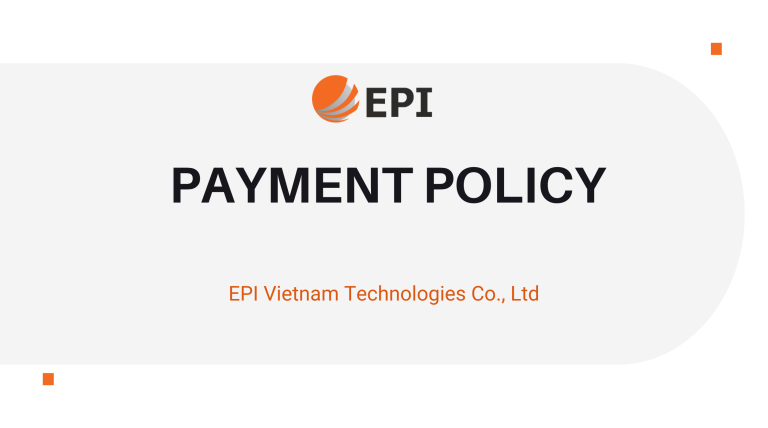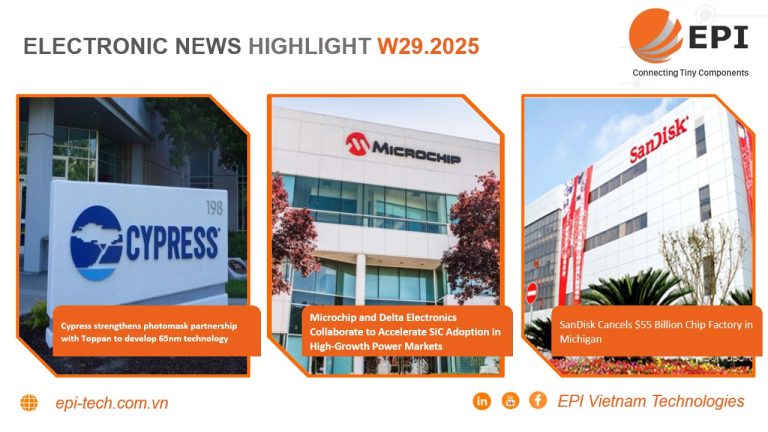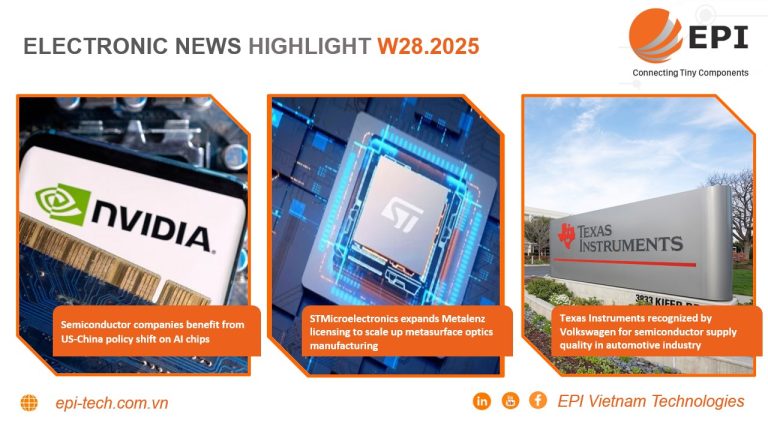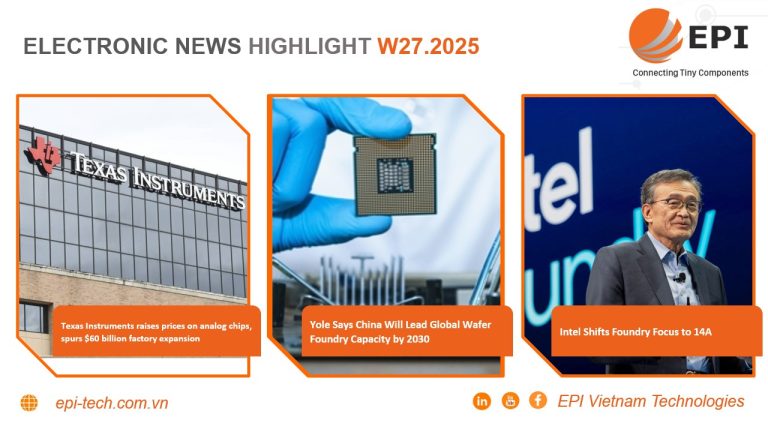ELECTRONIC NEWS HIGHLIGHT W27.2025
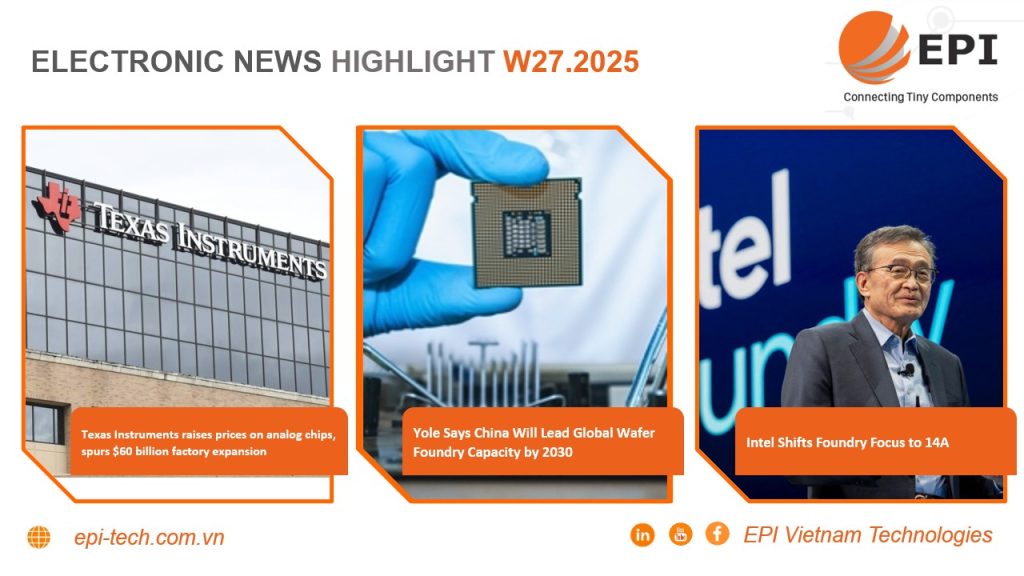
1. Texas Instruments raises analog chip prices, fueling $60 billion factory expansion
Texas Instruments is increasing prices on a range of data converter and analog chips, with some devices seeing price hikes of up to 100%, according to analysts at Bernstein. The move is aimed at boosting profit margins rather than responding to any component shortages.
In addition to price adjustments, TI is expanding its manufacturing capacity. The company is ramping up production at its 300mm wafer fabrication plant in Richardson, Texas, and has announced plans to invest $60 billion to build three additional fabs in the United States, reinforcing its domestic manufacturing strategy.
The global semiconductor industry remains in a phase of inventory correction. A surplus accumulated during the COVID-induced shortage, as customers overordered from multiple suppliers, continues to weigh on demand. Germany’s FBDi distribution group expects the market to recover in the second half of 2025.
Meanwhile, generative AI is emerging as a transformative tool in supply chain management. “By analyzing both structured data like inventory and transactions, and unstructured sources such as news articles and social media, GenAI provides a comprehensive view of potential risks and disruptions,” Hinds noted.
Distributors are beginning to see signs of demand returning. John Bowman, Marketing Director at UK-based Anglia, noted that suppliers are encouraging customers to place orders, warning that extended lead times may reappear by the end of 2025.
Learn more: Texas Instruments raises analog chip prices, fueling $60 billion factory expansion
2. Yole said that China to Lead Global Wafer Foundry Capacity by 2030
According to a recent report by Yole Group, China is expected to surpass Taiwan to become the world’s largest semiconductor foundry hub by 2030. The country is projected to hold 30% of global installed wafer foundry capacity by the end of the decade, up from 21% in 2024.
Yole’s data shows that Taiwan remains the leading contributor in 2024, accounting for 23% of global foundry capacity, followed by South Korea (19%), Japan (13%), the United States (10%), and Europe (8%). Southeast Asia, led by Singapore and Malaysia, represents 6%, driven primarily by foreign foundries operating in the region.
The report highlights the increasing regionalization of global foundry capacity. While global wafer manufacturing capacity is projected to grow at a CAGR of 4.3% through 2030, utilization rates are expected to hover around 70%, raising concerns over return on investment.
China’s foundry growth is particularly notable. According to SEMI, China’s wafer output rose by 15% in 2024, reaching 8.85 million wafers per month, thanks to the ramp-up of 18 new fabs. Capacity is expected to increase by another 14% in 2025, reaching 10.1 million wafers per month, far outpacing global growth forecasts.
Despite accounting for 57% of global wafer demand, U.S.-based semiconductor companies remain heavily dependent on overseas manufacturing, with only 10% of capacity located domestically. In contrast, Taiwan holds 23% of global capacity but only accounts for 4% of demand. Japan and Europe maintain a more balanced supply-demand ratio.
Learn more: Yole said that China to Lead Global Wafer Foundry Capacity by 2030
3. Intel Shifts Foundry Focus to 14A Process Node
Intel’s new CEO, Lip-Bu Tan, is reportedly weighing a major strategic shift in the company’s chip foundry business, potentially shelving the 18A process for external customers in favor of the next-generation 14A node, according to two sources familiar with the matter.
Since taking the helm in March, Tan has moved quickly to cut costs and reshape Intel’s approach to reviving its struggling foundry division. In an internal discussion held in June, he is said to have acknowledged that the 18A process—once a flagship investment under former CEO Pat Gelsinger—has been losing appeal among new customers.
According to industry analysts, withdrawing 18A and its variant 18A-P—technology developed over several years with billions of dollars in investment—from the external market could require significant write-downs, potentially ranging from hundreds of millions to several billion dollars.
Intel declined to comment on what it referred to as “speculative scenarios” but reiterated that 18A remains a core part of its internal product roadmap. The node is expected to power the “Panther Lake” laptop processors, slated to ramp in late 2025, and is considered the most advanced chip ever designed and manufactured in the U.S.
However, securing external customers remains key to the future of Intel Foundry. The company still plans to begin mass production of 18A chips later this year, although internal chips are expected to ship before customer orders are fulfilled.
In response to market dynamics, Tan is said to be reallocating resources toward the 14A process, which Intel believes will be more competitive with TSMC’s offerings. The company is currently fine-tuning 14A development based on the technical requirements of strategic customers, aiming to boost adoption and market positioning.
One of the sources noted that Intel’s board is expected to review proposals concerning the future of 18A foundry products as early as July 2025, following Tan’s directive.
Learn more: Intel Shifts Foundry Focus to 14A Process Node
#ASEAN #AsiaPacific #distributor #Global #electronicdistributor #PCBA



 English
English  Tiếng Việt
Tiếng Việt 







